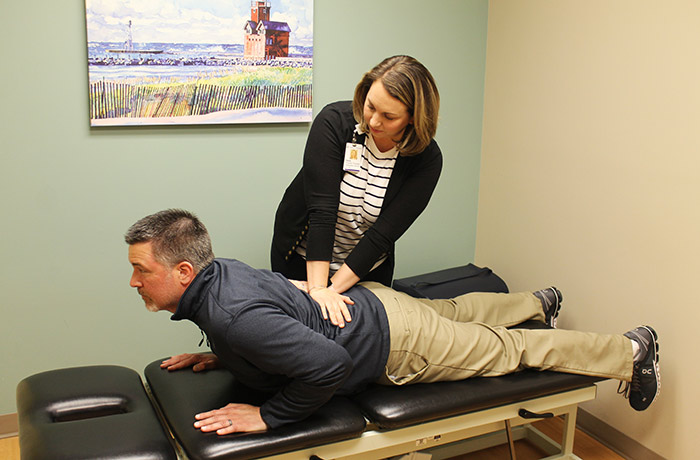
Until you feel a twinge, a throb or an ache, you probably take your back for granted. Yet with sitting, standing and moving, the human spine is almost in constant use. It’s no wonder why nearly 80% of Americans will experience back or neck pain at some point in their lives.
Despite this statistic, there’s good news when it comes to finding relief for back pain––and it may help you avoid surgery. The approach? Physical Therapy (PT) Rehabilitation.
“A recent study by Health Services Research states that, ‘A rehab or PT first treatment plan for back pain can decrease opioid use by 87%, lower the probability of imaging studies by 28% and reduce the incidence of ER visits by 15%,’” said Angela Kiekover, MSPT, Manager, Outpatient Rehab Services, Holland Hospital. “That not only means fewer side effects and risks, but also the potential for a quicker recovery and less out-of-pocket costs for patients.”
For those experiencing sudden or recurring back pain, Holland Hospital embraces this PT first approach. The process begins with a prompt referral from a primary care physician for an evaluation by one of our physical therapists specially trained in spine care. “Our goal is to decrease your pain, increase your activity level and enhance your quality of life,” Kiekover said. “We achieve this goal based on your unique situation and preferences, accessing neurosurgeons, orthopedic surgeons, physical medicine physicians and pain management specialists as needed.”
The Three Phases of PT
Physical therapy for back pain at Holland Hospital encompasses three phases:
- Protective-Phase 1: You receive a referral from your primary care doctor, and may see a physiatrist (physical medicine and rehabilitation physician) or pain management specialist for medications and/or specialized injections. Our spine care PT will also develop a plan to reduce the initial pain and address the source of inflammation. This includes education on why you hurt and learning how to properly move to alleviate pain. Heat and/or ice, electrical stimulations or other therapies may also be incorporated.
- Restorative-Phase 2: Once initial pain and inflammation are under better control, our team of rehab specialists will help you return to normal modified activities by establishing an exercise program that features stretching and strengthening for postural restoration, as well as instruction on a walking program or low-impact aerobic conditioning.
- Return to Activity-Phase 3: You will learn proper techniques to prevent further strain or injury to the back with higher level of activities. To build on endurance, flexibility and strength, an ongoing fitness regimen will be prescribed per your individual needs.
The Power of Prevention
Outside of physical therapy, these strategies can help you prevent back pain or stop it from returning:
- Exercise regularly. Lower-impact activities like swimming, walking and bicycling can boost fitness without straining your back.
- Stay at a healthy weight. If you’re overweight, dropping just a few pounds can make a big difference on your back health. (For every four pounds lost, 16 pounds of pressure is removed from the spine.)
- Sleep well. Aim to get seven to eight hours of sleep each day. It’s important to find the mattress that best supports your back during sleep.
- Quit smoking. Smoking cigarettes raises the risk of lower back pain that may require spinal surgery, according to this study.
- Focus on good posture when sitting and standing.
- Practice good body mechanics for safe and proper lifting.
Suffering from back or neck pain? Talk to your doctor about a referral to Holland Hospital Rehab Services. Our rehabilitation schedulers will get you in and on the path toward wellness fast. Call (616) 355-3930.